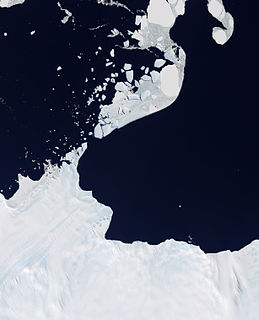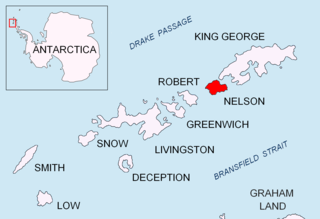
Tower Island is an Antarctic island 9 kilometres (5 nmi) long and 305 m (1,001 ft) high, lying 37 kilometres (20 nmi) north-east of Trinity Island and marking the north-east extent of Palmer Archipelago. The Pearl Rocks lie off its west coast.

Astrolabe Glacier is a glacier 7 kilometres (4 nmi) wide and 19 kilometres (10 nmi) long, flowing north-northeast from the continental ice and terminating at the coast in a prominent tongue at the east side of Geologie Archipelago. It was first sighted in 1840 by the French expedition under Captain Jules Dumont d'Urville, although no glaciers were noted on d'Urville's chart of this coast but a formidable icy dike with perpendicular flanks of 37.7 m high according to the joined plate, corresponding to the glacier tongue. The glacier was photographed from the air by U.S. Navy Operation Highjump in January 1947. It was charted by the French Antarctic Expedition, 1949–51, and named after d'Urville's flagship, the Astrolabe.

The Ibar Rocks are two rocks located 0.4 kilometres (0.2 nmi) east of Bonert Rock and 1 kilometre (0.6 nmi) southeast of Canto Point, Greenwich Island, in the South Shetland Islands. The names "Islote Ibar" and "Islote Teniente Ibar" appearing on Chilean hydrographic charts in the 1950s refer to the larger and western rock. The recommended name "Ibar Rocks" includes a submerged outlier to the northeast of the larger rock. Teniente (lieutenant) Mario Ibar P. signed the official act of inauguration of the Chilean Captain Arturo Prat Base on Greenwich Island in 1947.

Wiltshire Rocks is a group of rocks in the sea about 4.6 kilometres (2.5 nmi) east-northeast of Smith Rocks, 2.8 kilometres (1.5 nmi) east of Kitney Island, and 4.6 kilometres (2.5 nmi) northwest of Paterson Islands, off the coast of Mac. Robertson Land. First mapped from air photographs by the Lars Christensen Expedition, 1936–37, and named Spjotoyskjera. Renamed (1971) by Antarctic Names Committee of Australia (ANCA) for A.C.W. Wiltshire, cook at Mawson Station in 1963.

Andersen Island is an island 7 kilometres (4 nmi) west of Thorgaut Island, and 4 kilometres (2 nmi) east of Child Rocks, in the Robinson Group, Antarctica. It was mapped by the British Australian New Zealand Antarctic Research Expedition under Douglas Mawson in February 1931. The island was also charted from the whaler Thorgaut about the same time. It was named after Captain Lars Andersen of the whaler Falk who had assisted the Discovery with coal.

Anton Island is a low ice-capped island about 1 kilometre (0.5 nmi) long. It lies 9 kilometres (5 nmi) north-northeast of Lewis Island, just outside the east side of the entrance to Davis Bay. It was discovered in 1956 from the MV Kista Dan by an Australian National Antarctic Research Expedition led by Phillip Law that landed on the island on 18 January 1960, and was named by the Antarctic Names Committee of Australia for Anton Moyell, first officer on the MV Magga Dan in 1960.

The Canopus Rocks are two small, low rocks lying 2 kilometres (1 nmi) northwest of Canopus Island, 2 kilometres (1 nmi) east of Nella Rock and the Sawert Rocks, and 1.9 kilometres (1 nmi) southeast of Hansen Rocks in the eastern part of Holme Bay, Mac. Robertson Land. They were plotted from photos taken from Australian National Antarctic Research Expeditions aircraft in 1958, and named by the Antarctic Names Committee of Australia after Canopus Island.

Casy Island is the largest feature in a group of small islands lying 4 kilometres (2 nmi) southeast of Lafarge Rocks and 6 kilometres (3 nmi) northeast of Coupvent Point, off the north side of Trinity Peninsula. It was discovered and named by a French expedition under Captain Jules Dumont d'Urville, 1837–40.

The Child Rocks are a group of rocks at the west end of the Robinson Group off the coast of Mac. Robertson Land, 3.7 kilometres (2 nmi) west of Andersen Island. They were mapped by Norwegian cartographers from air photos taken by the Lars Christensen Expedition, 1936–37, and named "Vestskjera". They were renamed by the Antarctic Names Committee of Australia for J.B. Child, Third Officer of the RSS Discovery during the British Australian New Zealand Antarctic Research Expedition, 1929–31.

Welch Rocks are two rocks 1 kilometre (0.5 nmi) north of Welch Island in the east part of Holme Bay, Mac. Robertson Land. Plotted from photos taken from ANARE aircraft in 1958 and 1959. Named by Antarctic Names Committee of Australia (ANCA) after Welch Island.

The Swain Islands are a group of small islands and rocks about 3.7 kilometres (2 nmi) in extent, lying 0.9 kilometres (0.5 nmi) north of Clark Peninsula at the northeast end of the Windmill Islands. Delineated from aerial photographs taken by U.S. Navy Operation Highjump in February 1947. Named by the Advisory Committee on Antarctic Names (US-ACAN) for K. C. Swain who served as air crewman with the central task group of U.S. Navy Operation Highjump, 1946–47, and also with USN. Operation Windmill which obtained aerial and ground photographic coverage of the Windmill Islands in January 1948.

The Departure Rocks are a group of 4 steep-sided rocks lying 2 kilometres (1 nmi) north of Peake-Jones Rock in Holme Bay, Mac. Robertson Land. They were mapped by Norwegian cartographers from air photos taken by the Lars Christensen Expedition, 1936–37, and were so named by the Antarctic Names Committee of Australia because Australian National Antarctic Research Expeditions parties going west from Mawson Station on the sea ice always pass through or close to these rocks.

The Douglas Islands are two small islands 22 kilometres (12 nmi) northwest of Cape Daly, and 6 kilometres (3 nmi) north of Andersen Island, as well as 7 kilometres (4 nmi) north-east of Child Rocks, which are both part of the Robinson Group.. They were discovered by the British Australian New Zealand Antarctic Research Expedition under Mawson, 1929–31, and named for Vice-Admiral Percy Douglas, then Hydrographer of the Royal Navy. The islands were first sighted during an aircraft flight from the Discovery on Dec. 3 1, 1929, and reported to lie in about 66°40′S 64°30′E, but after the 1931 voyage they were placed at 67°20′S 63°32′E. In 1956, an Australian National Antarctic Research Expeditions sledge party led by P.W. Crohn was unable to find them in this position, but found two uncharted islands farther south to which the name has now been applied.

Pi Islands are two islands and several rocks which lie 2 kilometres (1 nmi) east of the northeast end of Omega Island among the Melchior Islands, Palmer Archipelago. The name, derived from the 16th letter of the Greek alphabet, appears to have been first used on a 1946 Argentine government chart following surveys of these islands by Argentine expeditions in 1942 and 1943.

Pig Rock is a rock, 65 m high, the largest of a group of rocks lying 1.9 kilometres (1 nmi) east of the east end of Nelson Island, in the South Shetland Islands. This rock, known to sealers in the area as early as 1821, was charted and named by DI personnel on the Discovery II in 1935.

Paterson Islands is a group of small islands lying 7.4 kilometres (4 nmi) northeast of Klung Islands, 3.7 kilometres (2 nmi) southeast of Wiltshire Rocks and Kitney Island, and 5.6 kilometres (3 nmi) southeast of Smith Rocks, close along the coast of Mac. Robertson Land. Mapped by Norwegian cartographers from air photos taken by the Lars Christensen Expedition, 1936-37. Named by Antarctic Names Committee of Australia (ANCA) for A.J.F. Paterson, supervisory technician (radio) at Mawson Station, 1963.

The Henkes Islands are a group of small islands and rocks 4 kilometres (2 nmi) in extent, lying 2 kilometres (1 nmi) southwest of Avian Island, close off the southern extremity of Adelaide Island, Antarctica. The islands were discovered by the French Antarctic Expedition, 1908–10, under Jean-Baptiste Charcot, and named by him for one of the Dutch directors of the Magellan Whaling Company at Punta Arenas. Charcot applied the name to the scattered rocks and islands between Cape Adriasola and Cape Alexandra, and the name was restricted to the group described by the UK Antarctic Place-Names Committee following definitive mapping by the British Antarctic Survey in 1961 and the British Royal Navy Hydrographic Survey in 1963.

Kitney Island is a small island 2 kilometres (1 nmi) east-northeast of the Smith Rocks, 2 kilometres (1 nmi) southwest of the Wiltshire Rocks, and 5 kilometres (2.5 nmi) northwest of the Paterson Islands, off the coast of Mac. Robertson Land, Antarctica. The Lars Christensen Expedition (1936) first mapped this island which, though left unnamed, was included in a small group named by them "Spjotoyskjera". It was remapped by the Australian National Antarctic Research Expedition (ANARE) in 1956, and was named by the Antarctic Names Committee of Australia for V.J. Kitney, a supervising technician (radio) at Mawson Station in 1968.
Smith Rocks is a group of rocks lying 1 kilometre (0.5 nmi) northeast of Canopus Islands, 1 kilometre (0.5 nmi) west of Kitney Island, 3.7 kilometres (2 nmi) southwest of Wiltshire Rocks, and 5.6 kilometres (3 nmi) northwest of Paterson Islands, in the east part of Holme Bay, Mac. Robertson Land. Mapped by Norwegian cartographers from air photos taken by the Lars Christensen Expedition, 1936–37, and named Spjotoyholmane. Renamed by Antarctic Names Committee of Australia (ANCA) for Captain V. Smith, RAASC, DUKW driver who took part in ANARE changeover operations at Davis and Mawson stations in 1958-59 and 1959-60.

![]()






